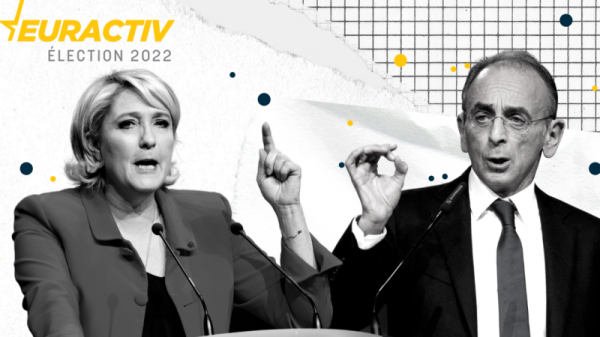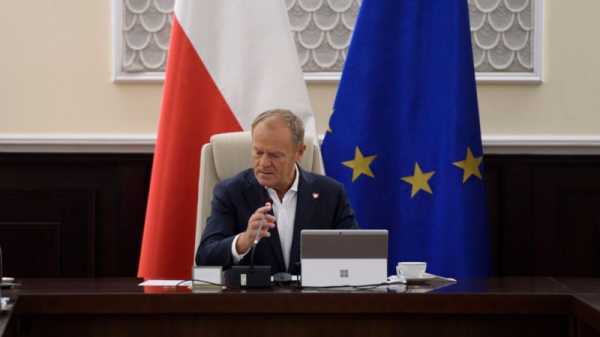
France’s far-right parties have never been so powerful in the polls as they are now, yet the wars being waged within the two biggest camps risk jeopardising the chances of their candidates reaching the second round in the presidential elections. EURACTIV France looks into what distinguishes their electorates.
If voting intentions for the French presidential elections of April were cumulated, one in three French voters would vote for Le Pen, Zemmour, and the less popular Debout La France candidate, Nicolas Dupont-Aignan.
For the first time, there appears to be a form of far-right primary that divides the nationalist camp. The contest is between Le Pen, the hard right’s ‘political dinosaur’, and Zemmour, the polemicist turned politician who wants to “save France”.
Different social and age groups
In both form and substance, Zemmour and Le Pen are adopting different strategies and political lines, proving the existence of two distinct electorates that are reshaping the far-right.
These differences are reflected in the voting intentions, Mathieu Gallard, research director at the Ipsos polling institute, told EURACTIV France.
“34% of workers would vote for Marine Le Pen against 6% of executives, whereas with Éric Zemmour there is much less of a sociological gap”, said Gallard. Zemmour’s electorate is more “affluent or middle class” compared to his competitor, he added.
As for age, Le Pen fares best with the “intermediate age groups (between 30 and 50)”, but is “much weaker among seniors”.
The age of Zemmour’s electorate is more consistent.
These figures can in part be explained by the fact that Zemmour “took a part of the traditional electorate of the Republicans […] and of the Fillonists [those who voted for the right-wing Les Républicains candidate] of 2017”, Gallard added.

French presidential candidates look to working class for votes
Three French presidential candidates carried out a large seduction operation over the weekend aimed at the working-class, the largest in numbers but least mobilised at the ballot box. EURACTIV France reports.
A ‘gender gap’ for Zemmour
The survey carried out by Gallard’s institute at the start of February, with a sample of 12,000 respondents, showed “a significant” six-point gap between Zemmour’s male and female electorate, both sitting at around 16% and 10% respectively, making “the gender variable very discriminating” for the far-right candidate.
Although the far-right electorate is commonly male, even in other European countries, “Le Pen had managed to put an end to this ‘gender gap’ in 2017, and is still succeeding,” said Gallard.
Zemmour’s very “conservative positions on values and the place of women” are the main reason women turn to other candidates, he added.

Zemmour presents anti-immigration EU vision similar to Le Pen's
Éric Zemmour, the fiery far-right candidate in the French presidential elections, chose to clarify his anti-immigration-focused vision of Europe in Calais. While he will not advocate for Frexit, he will try to renegotiate the Schengen agreement, and “if necessary” withdraw from the European Convention on Human Rights.
Swaying those who still hesitate
There are, however, possible “bridges” for those who remain hesitant about one candidate but have the other – Le Pen or Zemmour – as their second choice, Gallard also said.
The factors that can determine a change in choice include the ongoing campaign and the candidate’s public image. However, according to Gallard, one of the main factors to sway the electorate is “the capacity they have to let this electorate think that they have a chance of beating Emmanuel Macron”.
In terms of her image, Le Pen is judged to be “closer to the concerns of the French and capable of taking decisions”, which are “items on which Mr. Zemmour is not very well rated by the French as a whole”.
On a more institutional level, Zemmour’s image is “even more damaged than Marine Le Pen’s on aspects linked to competence, to the ability to lead the country, to the fact of being surrounded by people who could form a government”, Gallard added.
This is probably one of the reasons why Zemmour’s teams are focusing so much on poaching executives from the Rassemblement National. This could help Reconquête! – a party created to support Zemmour and reassure him of his capacity to govern – gain a more institutional stature.
The numerous rallies being held by both candidates are thus an opportunity for both camps to clarify their ideologies, especially since those who have left the Rassemblement National to join Zemmour were of a more liberal and identity-based line, while the party appears to now be drifting towards a more popular and socially-oriented one.
The two still feed on an obsession with identity issues, and in particular, Islam, although this subject monopolises almost all proposals of the former polemicist.
However, the Rassemblement National candidate also tries to focus on other issues like purchasing power to polish her image and thus capture a more diverse electorate.

Le Pen wants EU to be 'association of free nations'
After the defeat in the 2017 French presidential election, Marine Le Pen’s right-wing Rassemblement National renewed its discourse about Europe, aiming to appeal to a wider electorate, but it is uncertain if this shift will give Le Pen a shot at winning the keys to the Elysée Palace in April
Source: euractiv.com



